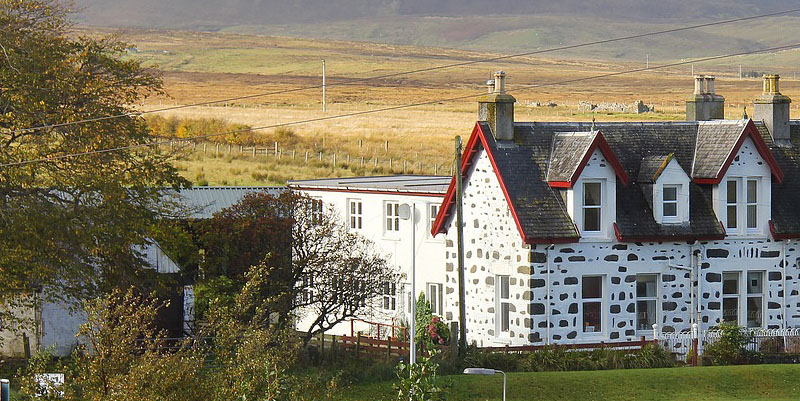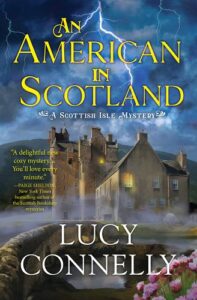When people ask me how I came up with the idea for An American in Scotland, I’ve never wanted to share the real answer. But the truth is: I wanted to run away from home. At the time, I had no plans to write a mystery set in Scotland. I just wanted to out of my house and to be anywhere else in the world.
Normally, when I create worlds for my books, it just comes to me out of the ether—or I channel it from higher power. I’ve never questioned the process it just happens. Out of the blue a character starts talking and the stories play out like a movie in my head. The town and the people come alive for me, and I just write down what happens. That’s my process.
There was a slight difference with An American in Scotland. Mentally, I needed a big break in 2021. You know what was happening, and if you too thought about running away from home, I see you. I understand. I’d been locked in my house for a year. Yes, I was with people I love. Yes, I had a full docket of books I had to write.
But I had this obsession. I wanted to hop on a plane and go to Scotland.
I’d just found out from DNA results I was 47 percent Scottish. Yep. I had no idea. Like many of us, what I’d been told by my relatives about my heritage was not true. I started researching those ancestors and looking at the places where they had lived. I was so drawn to Scotland––I can’t explain it. I felt like I needed to be there.
But no one, at that time, was hopping on a plane and flying much of anywhere. Scotland didn’t want our stinky American germs, and who could blame them. So, I did a deep dive into the place and the culture. I probably have thousands of photos of seaside towns, architecture in Edinburgh and Glasgow, and the beautiful Highlands on my computer.
I studied Scottish artists, writers, and politicians. I took visual tours so many times online, I dreamt I’d been to the places I’d seen. Then one morning I woke up and there was a doctor in my head. Her name was Dr. Emilia McRoy. She said, “I’m an ER doctor in Seattle and I need a change.” And mic drop. This place, Sea Isle, Scotland, formed in my brain. A small seaside town where the residents were incredibly friendly and quirky.
The setting can be an important whether it’s the Amish community in Linda Castillo’s Kate Burkholder series, or the village in Carlene O’Connor’s Irish Village Mystery Series, the sense of place brings the stories alive.
When Castillo is describing the Amish community in Painters Mill, there is a beautiful starkness there. The community is reserved, and stand-offish in a way. It is a beautiful place, and at the same time we sense a darkness there.
In direct contrast, who wouldn’t want to live in the bookstore O’Connor created for her series? Kilbane, Ireland in County Cork, sounds like a fun place to live––except, for the murders. These are two different communities that add a great deal to the overall story and the way it is told.
In Mango, Mambo, and Murder, Raquel V. Reyes brings the setting of Coral Shores, Miami to life. Readers feel the warmth and the breezes. The colorful shops and homes are all a part of what makes the place real in the reader’s mind. There is a vibe that is unique to Reyes’ stories.
Settings don’t just have to be towns and villages. In Kate Khavari’s A Botanist’s Guide to Parties and Poisons, she brings to life beautiful gardens, some of them extremely dangerous. While I’m not much of a gardener, she made me interested in creating one. Botany is a big part of the story, so it makes sense that Khavari would use plants and gardens to give a sense of place to her novel.
In An American in Scotland, Em’s house and office is a 400-year-old church that had been converted for the town doctor. And of course, it came with all the quirks a church that old might. Including strange noises in the night, which added to the atmosphere. The first thing she does is to paint and fix it up so that it feels more welcoming for her patients. Creating a place where people felt safe, told us a lot about who Em was.
I discovered different places in town as Em did. Step-by-step, we built this world where people helped one another out and solved weird murders. A community that she felt was the right place for her to be––even if it wasn’t exactly perfect all the time. But the “feeling” of the place was just as important to me. There had to be an emotional connection to the people and the town. To do that, I created a world I wanted to live in. I do that with just about every book, but especially with this story.
Each piece of stone in the cobblestone paths, every pastel store, told a little bit more of the story. Em’s favorite pub, The Pig and Whistle, has a welcoming interior, and the pub-goers are an interesting mix of human beings. She made one of the best friends of her life in that pub. The kind of friendship that stands the test of time.
While this idea of feeling alienated was mirroring society at the time I wrote the novel, it is a common thread with many of us. We need those connections. Whether it’s a barstool in “Cheers,” or the weathered couch at the station in “Vera,” we all need that place where we belong.
Creating a world where we could experience that sense of place was completely intentional in An American in Scotland. Sure, Sea Isle, Scotland is a fictional town, but I’m hoping readers will want to visit often, I know I do.
***


















